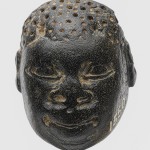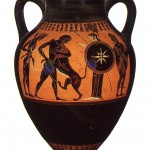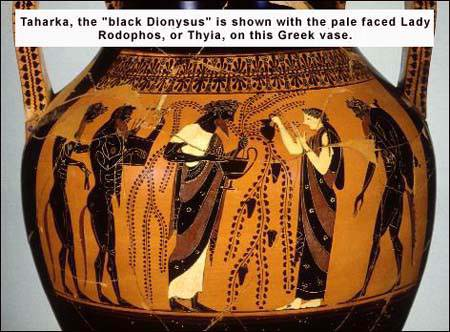
By Jide Uwechia with cited sources
The Benin Haplogroup or Haplogroup 19 Common in Africans, southern Greeks, Sicilians, and Albanians
There are at least four distinct African, (known as Senegal, Congo, Benin, Bantu Hbs Haplogroups) and one Asian chromosomal backgrounds (haplotypes) on which the sickle cell mutation has arisen.
The Benin haplotype (which originates from Nigeria, West Africa) accounts for HbS associated chromosomes in Sicily Northern Greece, Southern Turkey, and South West Saudi Arabia, suggesting that these genes had their origin in West Africa. The Asian haplotype is rarely encountered outside its geographic origin because there have been few large population movements and Indian emigrants have been predominantly from non HbS containing populations. Per:Graham R. Serjeant, MD, FRCP, The Geography Of Sickle Cell Disease:Opportunities For Understanding Its DiversityRSITY: http://www.kfshrc.edu.sa/annals/143/rev9239.html
Nigeria, west Africa appears the most logical origin of the sickle mutation in Greece evidence from beta S globin gene cluster polymorphisms (1991). It has been conclusively demonstrated that HbS in Greece is mostly haplotype #19 (the one that originated in Benin, Nigeria West Africa). See, Boussiou M, Loukopoulos D, Christakis J, Fessas P.; The origin of the sickle mutation in Greece; evidence from beta S globin gene cluster polymorphisms. Unit for Prenatal Diagnosis, Laikon Hospital, Athens, Greece.
Additionally, previous data suggest that the S/Bantu haplotype (from Southern Africa) is heterogeneous at the molecular level. Recent studies also report a similar heterogenity for the Benin Haplogroup. A study demonstrated the presence of the A -499 TA variation in sickle cell anemia chromosomes of Sicilian and North African origin bearing the S/Benin haplotype (from Nigeria). Being absent from North American S/Benin chromosomes, which were studied previously, this variation is indicative for the molecular heterogeneity of the S/Benin haplotype. Am. J. Hematol. 80:79-80, 2005.
A study was done in Albania (which borders Greece) relating to sickle cell anemia, sickle cell beta-thalassemia, and thalassemia major in Albania. The focus of the study was the characterization of sickle cell mutations. As one would expect, it was shown that the HbS mutation in the Albanian sample is the Benin (Nigeria)-originating haplotype #19. See, Boletini E, Svobodova M, Divoky V, Baysal E, Dimovski AJ, Liang R, Adekile AD, Huisman TH.; Sickle cell anemia, sickle cell beta-thalassemia, and thalassemia major in Albania: characterization of mutations. : Hum Genet. 1994 Feb;93(2):182-7.
According to a study done in 1973, before the availability of the advanced data cited above, “the occurrence of the sickle-cell trait in southern Europe …. is believed to reflect gene flow from the Middle East.” See A. P. GELPI, M.D, “Migrant Populations and the Diffusion of the Sickle-Cell Gene” August 1, 1973 vol. 79 no. 2 258-264 http://www.annals.org/content/79/2/258.abstract.
The problem with this 1973 study is that it assumes that the sickle cell genes came with the Arabs. Alas, updated research work has proven beyond doubt that the sickle cell genes proven to exist in southern Europe are exclusively Sickle cell gene Haplotype 19 or the Benin Sickle cell gene from Nigeria.
Y Haplogroup E-M78 and YAP In Black Africans and Greeks
Y Haplogroup E-M78 a derivative of E3B is a signature African gene as confirmed in research studies over the last few years. The high frequency of this haplogroup in Greece suggests the presence of a substantive African population in that region during prehistoric and historical time periods.
A recent paper has detected clades of haplogroups J and E3b that were likely not part of pre-historic migrations into Europe, but rather spread by later historical movements. Greeks .. [then there is] the marker J-M267, which may reflect more recent Middle Eastern admixture.
(Semino et al., Am J Hum Genet, 2004) E3b originates from East Africa while there is a high frequency of J-M267 in the East Coast of Africa as well as the Red sea coast of Arabia.
A recent sampling of the Greek population comprised 36 Peloponnesian samples, 5 of which were J-M172(xM12) and 17 of which were E-M78 (R.K., unpublished data).
In spite of the small Peloponnesian sample size, the high E-M78 frequency (47%) observed here is consistent with that (44%) independently found in the same region (Di Giacomo et al. 2003) for the YAP chromosomes harboring microsatellite haplotypes A. (Novelletto, personal communication) (Cruciani et al. 2004).
The study by by Di Giacomo et al. found the following African haplogroups in Greeks: Haplogroup A which is highly specific to West Africa, R1a, DE, and J2*(xDYS413= 18)J*(xJ2). R1* which probably gave rise to R1a is found in Northern Cameroon. DE is found principally among Nigerians and it is suspected that it originated from Nigeria. J is very prominent in East, and North Africa.
High-resolution Y-chromosome haplotyping and particular microsatellite associations reveal … an East Africa homeland for E-M78.Origin. See Ornella Semino, Chiara Magri, et al “Diffusion, and Differentiation of Y-Chromosome Haplogroups E and J: Inferences on the Neolithization of Europe and Later Migratory Events in the Mediterranean Area” http://www.pubmedcentral.nih.gov/articlerender.fcgi?tool=pubmed&pubmedid=15069642
HLA Genetic Relationship Between Ancient Greeks and Black Africans
HLA genes are reliable markers of past population movement and are still used in laboratories today to establish genetic inter-relationship amongst seemingly diverse peoples.
HLA genes in Macedonians and the sub-Saharan origin of the Greeks (2001) was a study conducted by Dr. Arniaz and other scholars in a top flying Spanish University. This study uses HLA genes to establish the African dimension of the roots of ancient Greece.
According to the Arniaz study, …Greeks are found to have a substantial relatedness to sub-Saharan (Ethiopian) people, which separate them from other Mediterranean groups. Both Greeks and Ethiopians share quasi-specific DRB1 alleles, such as *0305, *0307, *0411, *0413, *0416, *0417, *0420, *1110, *1112, *1304 and *1310. Genetic distances are closer between Greeks and Ethiopian/sub-Saharan groups than to any other Mediterranean group and finally Greeks cluster with Ethiopians/sub-Saharans in both neighbour joining dendrograms and correspondence analyses. The time period when these relationships might have occurred was ancient but uncertain and might be related to the displacement of Egyptian-Ethiopian people living in pharaonic Egypt. See Arnaiz-Villena A, et.al: HLA genes in Macedonians and the sub-Saharan origin of the Greeks. Tissue Antigens. 2001 Feb; 57(2): 118-27
There is a fraudulent claim (by those with idealogical investments in the topic) on the Internet that this study has been “retracted” or “refuted.” The study is perfectly valid. Sub-Saharan-specific and quasi-sub-Saharan-specific alleles were definitely detected in the Greek population at the DRB1 locus, and this is not open to question.
It would be helpful here to discuss the study that was retracted, and the reason why. It is the work titled: “The origin of Palestinians and their genetic relatedness with other Mediterranean populations” (which contained some cross-referenced Greek data in a neighbor-joining dendogram and a correspondence analysis) that was retracted. And it was retracted solely and strictly for political reasons, as this Observer article makes crystal clear:
http://www.guardian.co.uk/Archive/Article/0,4273,4307083,00.html
(Keep in mind we are dealing with the study on the relatedness of Jews and Palestinians at the moment, which was retracted, and not the one on the Greek-Black African relatedness, which was not retracted and remains valid. The two must not be confused.)
Appreciations to: http://onedroprule.org/about1071.html
Epilogue:
“Hb S is common in some areas of the Mediterranean basin, including regions of Italy, Greece, Albania and Turkey (Boletini et al., 1994) (Schiliro et al., 1990). Haplotype analysis shows that the Hb S in these areas originated in Africa. The genes probably moved along ancient trading routes between wealthy kingdoms in western Africa and the trade centers in the Mediterranean basin.” (Harvard University, http://sickle.bwh.harvard.edu/scdmanage.html)
“Usually, people with sickle cell disease outside Africa (e.g., blacks in the United States) or India have mixed haplotypes for their sickle cell genes.” (Harvard University, http://sickle.bwh.harvard.edu/scdmanage.html)
“Templeton gives a modern-day analogy: the presence of a gene for sickle cell anemia in Caucasians in Portugal. The gene traces back to a mutation that occurred in Africa and spread through interbreeding between Africans and Europeans. “The Africans didn’t come up, reconquer the Iberian peninsula, kill off all the Europeans, and that’s why there are sickle cell alleles in Portugal today,” he says. The presence of the sickle cell gene in Portugal “means that Portuguese and Africans have met and they’ve interbred, just like humans tend to do.” – “Out of Africa” – Ruth Flanagan, Contributing Editor, Earth Magazine, http://www2.mc.maricopa.edu/anthro/l…ofAfrica5.html




Respecting the age of this HBS haplotype 19 in Southern Europe including Greece:
“The lack of haplotype diversity associated with most of the malaria resistance mutations (â€HBSâ€) found in modern Mediterranean populations suggests that they have evolved within the last few thousand years.†See:
G O Tadmouri, N Garguier, J Demont, P Perrin, and A N Başak, ‘History and origin of β-thalassaemia in Turkey: sequence haplotype diversity of β-globin genes’, Human Biology, 2001, 73: 661–74; L Zahed, J Demont, R Bouhass, G Trabuchet, C Hänni, et al., ‘Origin and history of the IVS-I-110 and codon-39 β-thalassemia mutations in the Lebanese population’, Human Biology, 2002, 74: 837–47; S A Tishkoff, R Varkonyi, N Cahinhinan, S Abbes, G Argyropoulos, et al. ‘Haplotype diversity and linkage disequilibrium at human G6PD: recent origin of alleles that confer malarial resistance’, Science, 2001, 293: 455–62; L Luzzatto and R Notaro, ‘Malaria: protecting against bad air’, Science, 2001, 293: 442–3; P C Sabeti, D E Reich, J M Higgins, H Levine, D Richter, et al. ‘Detecting recent positive selection in the human genome from haplotype structure’, Nature, 2002, 419: 832–7.
Jeff
Africans have grown too sophisticated to be patronized. Thanks for your attempts.
Jahdey
Abubakar
When you grow up, seek out the work of the father of African studies in German Universities Leo Frobenius, and it will explain to you the connections between Nigeria and Greece.
I was not the first, nor will I be the last to posit such a claim and back it up with textual and genetic evidence. Just go carefully through the list of reference sources I have set out and make a call for yourself. Whether you agree with me or not is not my objective. My objective is to get you to read further, ask questions, do your own analysis, and then synthesize the information. Added two and two together…your conscience and cognisance will do the rest.
Jahdey
Sorry child but the only ignorant fool here is you. The irony is that you’re stuck on a spelling mistake when you can’t even spell my screen name correctly!!! Then again this coud be nothing more than further celebration of your inferiority complex in your strife to avoid addressing the original questions.
Does or does not the paper YOU cited by Graham clearly state that the distribution of sickle cell has NOTHING to do with ancestry.. simple yes or no ?
Does the Loukopoulos paper state that the distribution took place during the last millenium while you cite it as proof for your claims on antiquity? again a simple yes or no will do
Does the paper of your choice suggest that alpha cluster is either a Balkan or Anatolian marker?
The answer to all the above is YES.
So as already indicated your so-called “scholarship†is as worthless as your claims are. Nothing more than intentional distortion of papers in your strife to feed your humbled ego.
PS: so you resort to threats of banning since you can’t handle being exposed.. nice.
Ophesus Ignoramus
“Only a fool leaneth upon his own misunderstanding.”
A study by Di Giacomo et al. in 2003 found the following African haplogroups in Greeks: Haplogroup A which is highly specific to West Africa, R1a, DE, and J2*(xDYS413= 18)J*(xJ2). R1* which probably gave rise to R1a is found in Northern Cameroon. DE is found principally among Nigerians and it is suspected that it originated from Nigeria. J is very prominent in East, and North Africa.
Again I urge you:
Just cite one, one peer reviewed paper that disproves the thesis of the article:
(a)that ancient Greeks have HBS genes from Nigeria; Haplogroup 19.
(b)that ancient Greeks also carry genetic material originating from Ethiopia;
(c)that haplogroup A, and E-M78, are absent on the Agean Islands and as such in Greeks.
If you are unable to cite one scientific paper to counter my arguments or to support your own, then you remain the illiterate that you will always be.
Simply restricting yourself to cutting and pasting out of context quotes from papers I have already directed you to go read presents you as a mischeivious inadequate racist that is seeking to deny African people their ancient achievement; or you are just one huge irremediably damaged semi-illiterate. Do more independent research to show us how “superior in complex†that you are you little wretch. Show us a bit of your intellectual brilliance. Cite some peer reviewed papers!
Your Teacher
Jahdey
PS: Ignoramus, ridiculous is spelt with an “i†not an “eâ€â€¦you keep defacing this website with your bad grammar and spelling (rediculous). One more bad spelling and you will be fined. :-))
Ignoramus whines:…. so you resort to threats of banning since you can’t handle being exposed.. nice.
Jahdey replies: Ignoramus, fining is not banning. We threatened to fine you for your bad grammar and spelling. Not ban you. Again you demonstrate some symptoms of either myopia, dyslexia, or just plain old semi illiteracy. You must brush up on your reading and writing. :-))
I see your inferiority complex turned this into a debate on genetics since you simply dread to respond to the simple question of WHY YOU INTENTIONALLY DISTORTED THE CONTEXT OF THE ORIGINAL PAPERS YOU CLAIM TO HAVE CITED ?
Child, you simply fail to see that THAT is the issue, the INTENTIONAL DISTORTION.
You dare speak of copy/pastes when its you that parrtots the trash posted by Anu Mauro.. Who allegedly quotes Di Giacomo “Clinal patterns of human Y chromosomal diversity
in continental Italy and Greece are dominated by drift and founder effects”.. but its obvioius that the he just like you is driven by the same inferiority complex..
a) as already clarified in YOUR OWN choice of a source, Graham:
THE FACTOR IN COMMON TO THE DISTRIBUTION OF THE SICKLE CELL GENE IS THEREFORE MALARIA AND NOT AFRICAN ANCESTRY
b) name them.
c) Had the inferiority complexed child actually read the above mentioned paper of Di Giacomo he would have known that under chapt. “3.1. Hg frequency distribution in Italy and Greece” it is clarified that:
“Only a single Hg A individual was found, a findingwhich is in agreement with its rare occurrence outside Africa (Scozzari et al., 2001; Underhill et al.,2000).”
ONLY A SINGLE INDIVIDUAL!!!